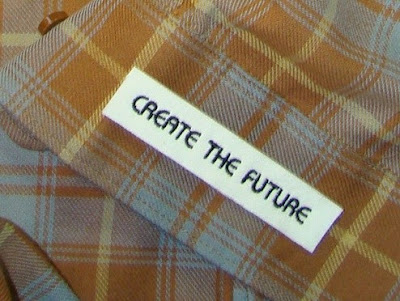Understanding the limitations of column width when it comes to digitizing is a lengthy learning process for a digitizer. To make it more difficult is when you do it for a living for customers not accustomed to things such as the width of a needle, different fabrics and how they react to a commercial embroidery machine, and the size and type of threads used.
More times than I can count, I've had customers request logos that could not be translated into embroidery at the size they requested and on the fabric desired.
In the case below, the first picture is the original logo. The width of the logo is a mere 3 inches by 1/2 inch tall.
The first problem is the small letters above measured in at .18 of a millimeter. In order to have enough room for the needle to make one column's width, you need a minimum of 1.0 millimeters. A needle measures in at .72 of a millimeter so you can see right away that a .18 is not going to be possible.
The second problem is the golfer that is sitting inside of the O. Remember what I said about the minimum size required. The distance left to right of the O was just at 1.0 millimeter so I can just barely get the O to spec and that's if there is no opening in the center of the O! I just stared at the poor golfer because I knew there was no way that I was going to be able to add him inside the O. It would be one big blob of thread.
The third problem but the easiest to fix was the word Classic. It at least was workable if I am able to make the logo bigger.
After modifying the customer's artwork, I made the necessary changes to the lettering so that it would stitch on a very thin moisture-wicking polo. I emailed it to my contact for approval. She gave me go and I started working on it. It was a slow process for such a small design. However, the end product stitched out quite nicely and looked very professional even at its small size. I tried to keep the customer's original artwork in mind with the design changes and added a modified golfer to the left of the artwork, allowing his left foot to be placed on the bottom part of the P and having the swing of the club nearly touch the top lettering. It appeared to be a win/win that the golfer was able to be kept even though he couldn't be inside of the O.
In order to get the upper lettering to remotely be stitchable, I had to again modify the artwork. The top lettering pushed the limits because it really ended up being just a tad shy of the 1.0 millimeter but I couldn't go any larger without making the entire logo larger than the customer wanted.
Ultimately the size ended up at 4 inches wide by .93 inches tall. This is as far as this logo went because the modified logo was rejected by the design department. They were not happy with having any changes made to their logo. I completely understand their feelings, but unfortunately there is only so much you can do if the specs of a design are out of whack with the chosen method to apply it.
I'm not sure what was ultimately done for the logo. Perhaps they decided to go with a screen print which doesn't have the same limitations of embroidery or whether they skipped branding the polos altogether. It was a learning experience for me as well because this is the first customer in nearly 12 years that approved changes but then rejected the finished design made with those changes.
Whenever possible if you can become involved with a customer prior to a design being finished, it will help tremendously because you will be able to help educate on what can and cannot be done depending on the size of a design.




Wow! What a lot of work and then you didn't get to actually stitch the design on the intended product. I wonder what they would think if you just imported the design as is and stitched it out. . .then, worked your magic so that the customer might understand about the 1.0 mm space. --Terry
ReplyDeleteYes, that would have been nice to be able to that. There was no way for me to import their jpg and be able to embroider it without manually creating it knowing that I wouldn't be able to embroider it on my machine.
DeleteMost of the time the process of describing what is doable to a customer goes well. In this instance, there was an additional layer of customer that I could not communicate with and they ultimately were the decision makers.